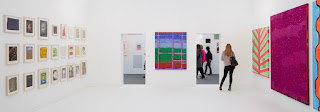How Galleries Can Get the Most From Art Fairs
With unstable markets and cautious
collectors, art dealers everywhere are adopting leaner strategies that make the
most of their gallery’s resources.
Driving
40% of annual gallery revenue, according to TEFAF’s 2015 Art Market Report, art
fairs remain a
crucial part of the bottom line, providing global reach without the need for
multiple locations. The opacity of the primary market, paired with journalism
that focuses on anecdotal highlights, can make it challenging for galleries to
understand the international landscape when deciding to apply to an art
fair.
Over the last three
years Artsy has covered over 100 top art
fairs, featuring more than 100,000 fair artworks uploaded by
exhibitors. Never before has such a comprehensive database of fair works
existed in one place, presenting a unique opportunity to glean information
about the art fair landscape. We hope our analysis of this data will provide
insight into market trends and empower galleries to represent their gallery
program.
This two-part
Gallery Insights series shares our key findings and includes interactive graphs
for you to review at leisure. In Part One, we look at the age of
artworks and artists as a lens through which to explore the anatomy of an art fair.
Artwork
Ages at Fairs
When looking at an
art fair layout, you’ll likely notice that gallery booths are often organized
by the age of
their artworks.
At Art Basel in
Miami Beach, the Nova section is designed to showcase works created within the last three years,
while the Survey section focuses on rediscovery and
historical projects. These themes are common in exhibitor programs at art fairs
around the world.
Age tells the story
of whether gallerists are shipping works straight from artists’ studios,
feeding the desire for fresh work, or digging into reserves to showcase mature
pieces.
